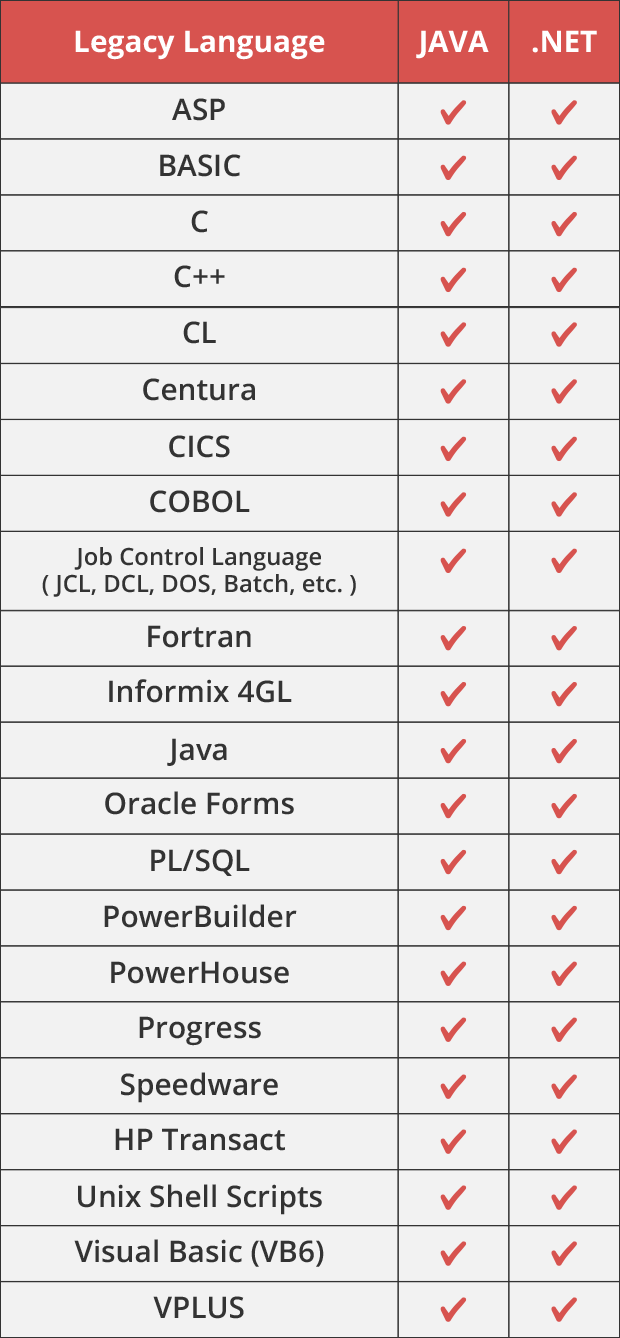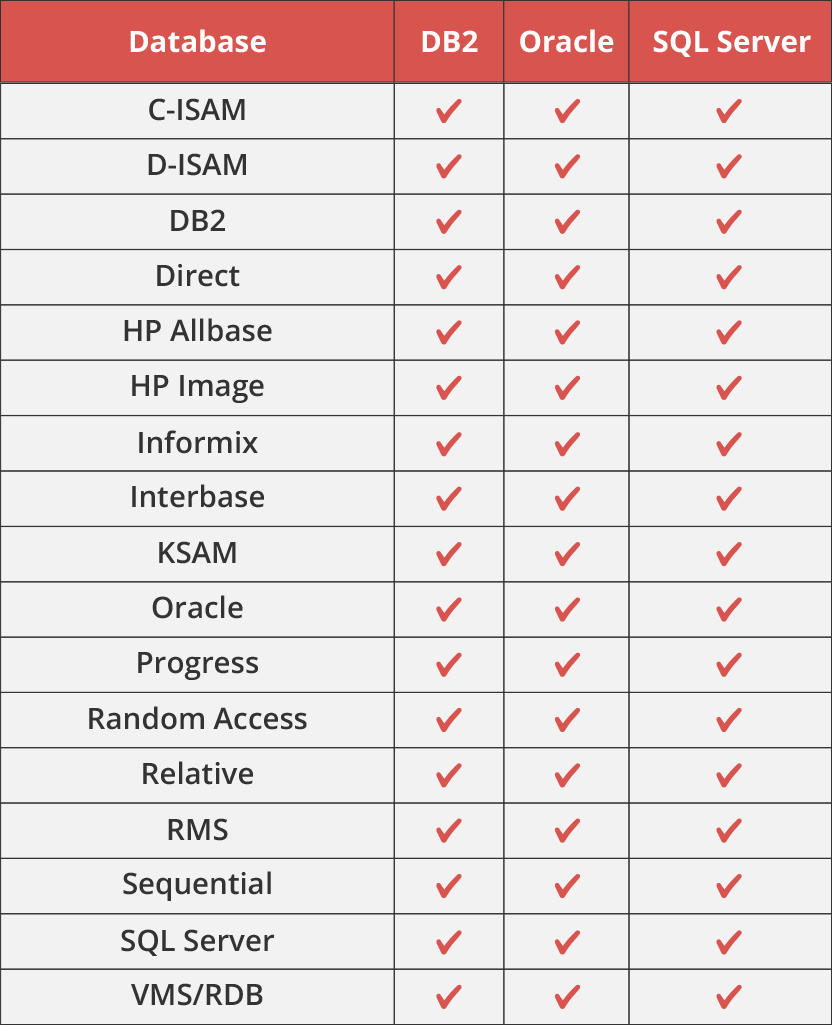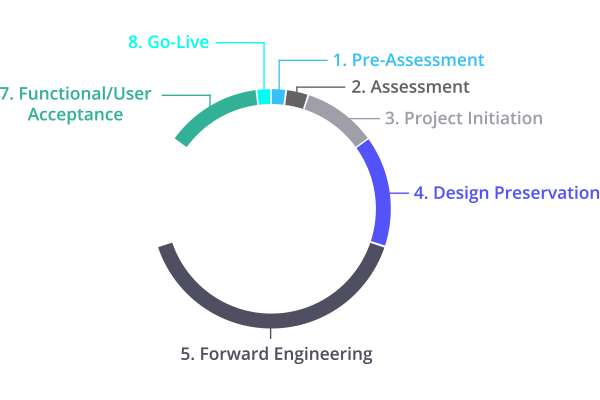THE MODERNIZATION METHOD
At the heart of your organization is a mission-critical core software application built using legacy applications, such as COBOL, PowerBuilder, Progress, PowerHouse®, Speedware, FORTRAN, Transact, VPLUS, etc. It is the essence of your business. Its millions of lines of custom code contain core business knowledge that meet your unique needs. It is deeply integrated with other systems and is relied upon by scores of end users.
It is your core. Don't abandon it. Don't replace it. Preserve, leverage and extend it. With CORE Migration.
CORE Migration is the proven method for moving mission-critical legacy applications to modern computing platforms. It combines a rigorous set of procedures, precision-engineered software tools, and an experienced team of dedicated professionals to dramatically accelerate the migration process.
MODERNIZATION PLATFORMS
CORE Migration is the proven method for moving legacy applications to modern computing platforms. All CORE Migration solutions combine extensive experience with a rigorous set of procedures, precision-engineered software tools and an experienced team of dedicated professionals to accelerate the migration of legacy 4GL platforms.
All migration solutions include the migration of the data and data structures of the application to leading-edge Relational Database Management Systems (RDBMS) including Microsoft SQL Server, Oracle, DB2 and Eloquence, to name a few.
The following data sources and target databases are supported.
MODERNIZATION TECHNOLOGY
CORE Migration relies on a workbench of proven, specialized software tools that are precision-engineered to accelerate the legacy migration process and eliminate many labor-intensive tasks.

The CORE Migration workbench provides a consistent and structured environment in which CORE Migration professionals execute all the tasks associated with the legacy migration process. The workbench has been designed to ensure consistency in approach and to guarantee that the results of the migration are predictable, repeatable and of the highest quality. The components of the workbench include the following:
Design Preservation Toolkit. A series of high-speed parsers that scans the legacy system data definitions and source code and creates the intermediary API files that are loaded into the repository.
Repository. An object-oriented relational database and library of Application Programming Interfaces (API) that validate incoming data and ensure the recovered application is consistently represented and stored in the form of objects, methods and business rules that make up the underlying application.
Forward Engineering Toolkit. An integrated application development toolkit that uses the information in the repository to perform an assortment of tasks including re-documentation, application and data definition navigation, and impact analysis as well as forward engineering to various target environments. The target application development environments and technologies currently generated by the tool include Microsoft .NET and PowerHouse porting. The target database environments include Oracle, SQL Server and DB2 and Informix (from Image, RMS, C-ISAM, Rdb, Eloquence, etc.).
MODERNIZATION PROCEDURES
Each Modernization Project follows the same rigorous set of procedures, which have been developed and refined specifically for legacy applications. This disciplined approach ensures that the end result matches expectations, and that the process is completed on time and on budget. CORE Migration procedures include a number of activities beyond simple application migration. These activities address project management, configuration management, quality assurance, release preparation and delivery, training preparation and delivery, and support; all necessary elements of any successful project.
Unlike traditional lifecycle development methodologies, CORE Migration effectively eliminates the time and effort otherwise required to complete system requirements and design. It also dramatically reduces the traditional code-and-build time of a project.
The CORE Migration process is broken down into these phases:
MODERNIZATION BENEFITS
The benefits of using the CORE Migration method to move your legacy application to a modern computing platform include the following:
- 100% Guarantee - Duplication of existing functionality.
- Increased business flexibility, functionality and user productivity.
- Cost savings.
- Reduced risk.
- Increased revenues.
Increased business flexibility, functionality and user productivity
- Preserves the valuable intellectual property contained within the business rules and logic of legacy applications such as PowerHouse, Transact and VPLUS.
- Leverages the enhanced features, functionality and usability of modern technology - including navigation, colors, pop-ups, drop-down menus and icons - in your new application.
- Extends the application to include enhancements, customizations and broader integration.
All of this provides a more robust, flexible foundation that better supports current and future business growth.
Cost savings
- Accelerates an otherwise labor-intensive, legacy application migration process.
- Significantly improves end-user productivity by leveraging the many features of a modern software application including navigation, desktop integration (email, word processors, etc.), and hyperlink capability.
- Allows employees, partners and clients the option of accessing the application - both locally and remotely - via the Web, while reducing the cost of supporting them.
- Eliminates the ongoing labor, support and maintenance costs of increasingly obsolete technologies and skills, while allowing you to leverage existing IT investments.
- Offers lower training, maintenance and enhancements costs.
Reduced risk
- Shortens the time-to-market for the new application.
- Minimizes the disruption to ongoing business operations.
- Reduces the dependence on obsolete technologies and skills.
- Aligns with - and leverages - proven, modern IT standards, both within your organization and the industry.
Increased revenues
- Enables end-users to be more productive, and to focus on higher-value, revenue generating tasks.
- Extends the application to new users and markets that would not have otherwise been served.
A CORE-DIRECTED MODERNIZATION PROJECT
CORE offers two mechanisms in which to execute the project. The CORE-Directed apprach and the SELF-Directed approach.
Using the CORE-Directed approach, we apply the method and manage the legacy migration from start to finish. Our people perform the procedures, operate the technology and carry out the bulk of the migration tasks. The CORE-Directed option is for organizations that want the fastest migration possible, aren't overly concerned about the inner workings of the new application, or who lack the skills, resources or time necessary to perform the migration themselves. This diagram illustrates which steps in the legacy migration process are performed by the CORE Migration team ("CORE") and which ones are performed by you ("Client"). Request a case study to learn how one organization successfully completed a CORE-Directed Migration.

A SELF-DIRECTED MODERNIZATION PROJECT
Under a SELF-Directed approach, Our people help you plan your legacy migration, and then train you to use the output of the tools so that you can perform the migration yourself. The Self-Directed option is for clients who wish to be more involved with the application migration process and have the resources, time and technical skill-sets necessary to complement the migration project. This diagram illustrates which steps in the legacy migration process are performed by the CORE Migration team ("CORE") and which ones are performed by you ("Client"). Request a case study to learn how one organization successfully completed a CORE-Directed Migration.











